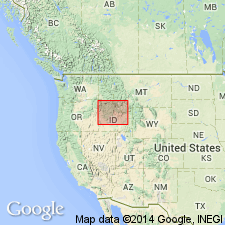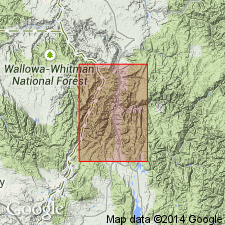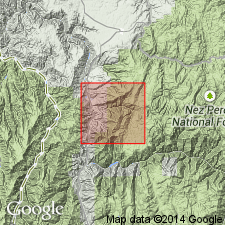
- Usage in publication:
-
- Berg Creek Amphibolite
- Modifications:
-
- Areal extent
- AAPG geologic province:
-
- Idaho Mountains province
Summary:
Pg. 63, 65. Berg Creek Amphibolite of Riggins Group. Structurally highest formation in Riggins Group. Name credited to Warren Hamilton (in press) [USGS Prof. Paper 436, 1963].
Source: US geologic names lexicon (USGS Bull. 1350, p. 60).

- Usage in publication:
-
- Berg Creek Amphibolite*
- Modifications:
-
- Principal reference
- Dominant lithology:
-
- Amphibolite
- Schist
- AAPG geologic province:
-
- Idaho Mountains province
Summary:
Pg. 17, 27, pl. 1 (geol. map). Berg Creek Amphibolite of Riggins Group (new). Formal proposal of name. Schistose amphibolite and hornblende-rich schist. Oligoclase, andesine, and hornblende are common minerals. Present thickness about 1,000 or 1,200 feet; original thickness unknown, section complicated by much deformation. Lies below Squaw Creek Schist [See Note Below] and above Lightning Creek Schist (both new; both of Riggins Group). Recognized locally in Berg Creek area. Absent along Salmon River north of Riggins (type section of Riggins Group); there an intercalated metaperidotite (unnamed) separates the Lightning Creek and Squaw Creek Schists. Age is considered Paleozoic or Mesozoic; younger than Cambrian and older than Idaho batholith (middle Cretaceous).
[Typographical error (US geologic names lexicon, USGS Bull. 1350, p. 60): stated thickness of 1,000 to 2,000 feet incorrect.]
Type section: 3.5 mi east of Riggins, in north wall of Salmon River Canyon [in vicinity of river mile 90, in sec. 18, T. 24 N., R. 2 E., Riggins 7.5-min quadrangle, along southern bdry Nez Perce National Forest], Idaho Co., western ID.
Named from Berg Creek, a tributary to Salmon River just east of type section [confluence at western edge of Riggins 7.5-min quadrangle].
[Additional locality information from USGS GNIS database and USGS historical topographic map collection TopoView, accessed on September 4, 2023.]
[NOTE: In accordance with Department of Interior's Secretarial Order 3404, discontinuing use of derogatory term squaw, the Squaw Creek Schist is in process of being formally renamed either Yeva Agai Schist or Yeva Agai Naokwaide Schist (BOTH RESERVED). The geographic feature Squaw Creek, from which the geologic name was taken (this report), was renamed Yeva Agai Naokwaide by U.S. Board on Geographic Names, September 2022, USGS GNIS FeatureID 391296.]
Source: Publication; US geologic names lexicon (USGS Bull. 1350, p. 60).

- Usage in publication:
-
- Berg Creek Amphibolite
- Modifications:
-
- Not used
Summary:
Some medium- and high-grade metamorphosed volcanic rocks mapped east of the Salmon River area are mapped as metamorphic units whose relative age and correlation are unknown; these rocks are tentatively correlated with the Seven Devils Group; they are shown as Permian and Triassic age; they are also mapped as present in two plates--the Rapid River and North Fork plates--of the Wallowa terrane. These metamorphosed rocks were previously assigned to formations of the Riggins Group. There is no evidence found during this study to indicate that rocks of the Riggins and the Wallowa are different island arcs. Also, all identifiable map characteristics useful for distinguishing the formations have been obliterated by multiple episodes of metamorphism and deformation. The mapped units cannot be correlated with or assigned to individual formations with confidence. Therefore, the name Riggins and its component formations are not recognized in this study.
Source: Modified from GNU records (USGS DDS-6; Denver GNULEX).
For more information, please contact Nancy Stamm, Geologic Names Committee Secretary.
Asterisk (*) indicates published by U.S. Geological Survey authors.
"No current usage" (†) implies that a name has been abandoned or has fallen into disuse. Former usage and, if known, replacement name given in parentheses ( ).
Slash (/) indicates name conflicts with nomenclatural guidelines (CSN, 1933; ACSN, 1961, 1970; NACSN, 1983, 2005, 2021). May be explained within brackets ([ ]).

